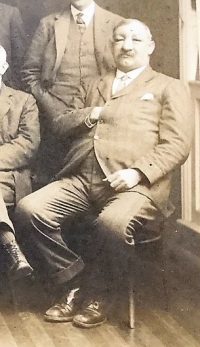
Alan Simpson, a resident of Richmond called into the musueum to tell us about his grandfather. After months of collecting stories from the time of the First World War for the Ribbon of Remembrance, we have our first story relating to our rural location.
Henry Barningham Simpson farmed at High Rockliffe Farm Hurworth during the First World War. He was also given the role of official horse buyer to the War Department during the conflict. Alan Simpson recalled, “I know he had to travel to very many farms selecting the best of the cart horses to pull the guns and carts of the army. My dad told me that he hated having to take the farmers best and most useful horses. He knew very well that a lot would be killed or injured from the shelling, ‘blown to pieces’ were his actual words. I suppose he was given some leeway in selecting which horses to buy as food still had to be produced, how they were selected he never said but I suppose they had to be fit for purpose whether they be cart horses or hunters for the cavalry”.
The requisitioning of horses during the First World War was dealt with by the Army Remount Service. This department existed before the conflict broke out, with a total establishment of 25,000 horses and mules, five Remount Depots and four Remount companies, with a strength of approximately 1,200 animals. Within 12 days, the establishment had been increased to 165,000 animals and a year later, in August 1915, to 534,971. At its peak in 1917, the Army establishment reached almost 870,000 horses and mules, with remount accommodation for 60,000 animals. Over the course of the war, a total of 468,323 horses were purchased in the United Kingdom by local offical horse buyers such as Henry Barningham Simpson.

Requisition order from the first day of the First World War
Explore more memories from the ribbon
-
Harold Surtees
Jonathan Helm submitted this information about his Great Grandfather, Harold Surtees. Lance Corporal Surtees (2048/200407), was born in West Hartlepool and lived in Great Ayton. He volunteered for service in a local meeting on 2nd September 1914. Serving with the 1st/4th Battalion Yorkshire Regiment, he was posted to France as part of the 50th Northumbrian Division on 18th April 1915. Although little is known of his exact war record, his photograph indicates two wound stripes and the Whitby Gazette when reporting his death noted that he had been “three times wounded and gassed”. The only confirmed record of wounding is in the War Office Casualty List, which was printed in The Times on Wednesday 25th October 1916. This is likely to have occurred during the Battle of Flers-Courcelette (15th – 22nd September 1916) which was fought during the Battle of the Somme. He died on the 10th April 1918 (aged 26) from wounds sustained when the battalion fought at the Battle of Estaires in an attempt to stop the German advance. Harold is buried at the Haverskerque British Cemetery in France. He left behind his wife, Sarah, and their two children, Harold and Mary.
-
Ernest Brooke
Sgt. Ernest Brooke was born in Brighthouse, Yorkshire in 1886. In civilian life Ernest worked a railway signalman. Ernest’s medal records show he was entitled to the 1914 Star indicating that he was an ‘Old Contemptible’, part of the original British Expeditionary Force that fought in France and Belgium from August 1914. Ernest served with the 2nd Battalion of the Yorkshire Regiment until his death on 4th January 1918. The New Year 1918 that at 11pm (German midnight) on the 31st December 1917, ‘…all guns of artillery fired one round each, whilst machine guns fired two belts of ammunition each ‘to usher in the new year’. The following day, the 2nd Battalion were relieved from the front line and relocated to ‘Hedge Street Tunnels’. On the night of the 4th of January, a fire broke out in the area of the tunnel being occupied by the Battalion, resulting the loss of a further 20 lives from the 2nd Battalion – one of those lives being Ernest Brookes’. In accordance with his wishes, Ernest’s outstanding pay and War Gratuity, totalling £29, 7shillings and 19d to his mother, Hannah.
-
Sapper Joseph William Colling
William Colling – Sunderland Joseph William Colling was the father of Brenda Crinall of Little Crakehall, who called in at the museum with a friend who wanted to contribute a story to the Ribbon of Rememberance. Brenda didn’t really know a great deal about her father’s participation in the war, but was interested when we offered to take a look and see if any records still existed from that time. As fortune would have it, her father’s service record was available to see and so we were able to piece together some of his experiences from the time of the First World War. Before enlisting Colling worked as a sorting clerk and telegraphist for the G.P.O. in Sunderland. Prior to going to German East Africa (G.E.A.) in 1916 he served for 13 months in France. Some of the most dangerous activities he undertook was to lay cables as close to the enemy lines as possible. These cables were essential for information and orders to be relayed to and from the battlefront. In 1916 the German plan for war in G.E.A. was to divert Allied forces away from the Western Front in Europe. Colling sailed from Devonport on the 8th of February 1916 and he arrived in Durban on the 6th of March.On the 14th of March he arrived at Kildini inlet near Mombassa. Over the next few months he and his comrades came under heavy attack several times as they advanced south towards German forces.This included fierce action near Kilosa….
